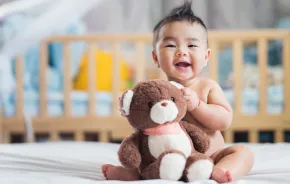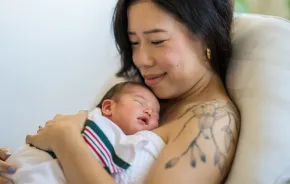Is your home an endless sea of toys that seemingly only you are able to pick up? Do you daydream of an organized play area that inspires your little ones to learn and explore? It's all possible when you create an educational environment in your home.
The benefits of such a setting are clear. First, you help your children develop important skills -- including small motor, pre-math, reading and science -- while having fun in their own home. Second, you enable them to focus and complete tasks -- choosing an activity, playing with it and then cleaning it up -- all on their own. In addition, children who are surrounded by a simplified and organized playroom are often calmer and less prone to tantrums, and gain self-esteem by becoming more self-reliant.
A good place to start in simplifying your playroom begins with critically looking at the toys that your children have and asking the question: What do they currently play with? Any toys that they have outgrown should be donated or stored in a labeled container if younger siblings will be able to use them later.
Here are a few more tips to help organize the remaining toys and create a more educational environment for your child.
- Focus on quality, not quantity
Do your children complain of being bored even though they have a tremendous amount of toys at their fingertips? Many playrooms are permeated with bright plastic objects that do little more than create noise. Children become easily bored with these toys because they offer few educational benefits. Quality toys engage children for hours and allow for many different avenues of exploration. - Rotate toys
Children can lose interest after seeing the same toys day after day, which leads parents to buy even more toys. Instead, rotate your educational toys daily, weekly or monthly depending on your child's interest. You can even create rotation schedules to follow themes or seasons. If you have 20 puzzles, for example, choose three for the week and keep rotating them instead of putting them all out at once. For preschoolers, it's like getting new toys each week. - Limit the amount of pieces
Many toys come with hundreds or thousands of pieces. A 3-year-old, however, doesn't need to play with 300 Zoobs. When faced with so many pieces, young children view it as an opportunity to pile, horde and stash rather than engage in the small-motor-skills development it could provide. Instead, choose toys with a smaller number of components. An added bonus: Clean-up is easier because the task is not so daunting. - Avoid toy bins
Toys that are arranged neatly on low-lying shelves with plenty of space between them are more enticing to children, easier to see and -- since everything has a specific place -- easy to clean up. If you feel you need a big toy bin, you probably have too many toys. - Let your child be your guide
When choosing toys, always look to your child for direction. If he or she is fascinated with dinosaurs, don't buy 50 plastic dinosaurs. Instead, find or create various activities with a different educational focus (such as reading or math) while using dinosaurs as your medium. And above all, if your child is thoroughly engrossed in an activity, allow him or her to play undisturbed.
By creating an organized educational environment, you are providing a special space for your preschooler to play, explore and -- most of all -- have fun.
Rosalee Dotson is a consultant for Northwest Parenting Consultants and a French and Spanish tutor for young children. She can be reached at rosalee@nwparenting consultants.com.
Preschool play recommended reading:
- Your Child's Growing Mind, by Jane M. Healy.
- Montessori From The Start: The Child at Home from Birth to Age Three, by Paula Polk Lillard and Lynn Lillard Jessen
- Play With a Purpose: Learning Games for Children Six Weeks to Ten Years, by Dorothy Einon









